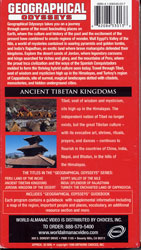St. Gregory College Preparatory School
3231 N. Craycroft
Tucson, AZ 85712
(520) 327-6395
Vidoes about Tibet
Geographical Odysseys
Ancient Tibetan Kingdoms


This video is a wonderful, very condensed, and visually stimulating survey of several places where the very old yet still vital traditions of ancient Tibetan Buddhism are still very much alive. None of the footage is acutally taken in Tibet, which is something of a drawback, but the virtue of this video is the wide ranging geographical diversity it illustrates. It reaffirms that Tibetan Buddhist traditons, of all four schools, are still very much alive in places that until recently were not well known; in fact, many of these places were closed by their respective governments. This video also uses the method of following one of ancient Tibetan Buddhism's most famous lamas, Padmasambhava,,and his journeys.
(Click to enlarge image)
Content questions:
Part I: Katmandu
1. Why do pilgrims come to Katmandu?
2. When did monasteries develop?
3. What is a stupa?
4. What, according to the film, is the meaning of an ethnic Tibetan?
Part II: Ladakh
1. Where is “Little Tibet?”
2. Why is it so hard to get there?
3. What is a mantra?
4. When was the area founded and by whom?
5. What is a gampa and how is it supported?
6. What is the purpose of the monks’ dances?
7. Who are the Yellow Hats?
8. What do the masks represent?
9. What is a tangka?
Part III: Mustang
1. Describe the topography of Mustang.
2. What is the significance of the number 108?
3. What crops are found in Mustang and which is the staple food?
4. What is a chorten?
5. Which school of Tibetan Buddhism is most associated with Mustang?
Part IV: Sikkim
1. Who controls Sikkim politically?
2. What is a lineage in Tibetan Buddhist terms?
3. Who are the Red Hats?
Part V: Bhutan
1. What does this name mean?
2. Give reasons for describing it as a paradise?
3. Compare it with Ladakh?
4. What is a guru?
Vocabulary List
Stupa
Prayer flags
Mantra
Gampa
Tangka
Rosary
Kanjua
Tsampa
Chorten
Lineage
Guru
The Four Schools of Tibetan Buddhism:
Sakya
Gelugpa
Nyingma
Kadyu
Discussion Questions:
1. How does geography dictate the lives of the people in Himalayan region? Consider such issues as agriculture, weather, economics, location, isolation.
2. What kinds of dress can be observed?
3. What instruments are used and from where might they originate?
4. What demarcates the different schools of Tibetan Buddhism in the video and speculate on how and why these differences arose?
5. What different issues might face Buddhists in Nepal, India, or Bhutan vs. those in Tibet, now part of China?
6. What is the future of these remote places in the twenty first century?
7. Explain the importance of Padmasambhava. Speculate on what his life might have been like? What motivated him to travel? What does his life say about Buddhism?

Image of Padmasambhava from
The Life and Liberation of Padmasambhava
by Yeshe Tsogyal
Dharma Publishing, 1978
Emeryville, California
This site was created by Robert C. Mossman at the NEH Summer Institute "Cultures and Religions of the Himalayan Region," held at the College of the Holy Cross, Summer 2004